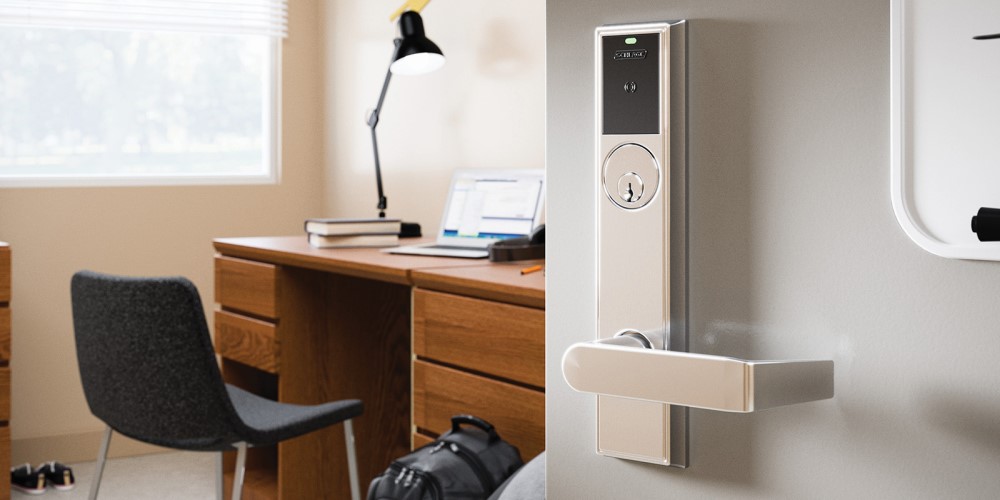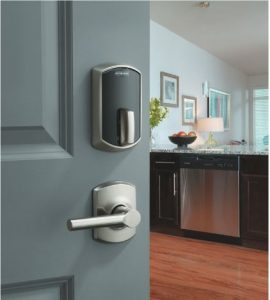6 Reasons to Go Wireless With Your Access Control Solutions
Depending on the application, a wireless option may be the best access control solution. Discover the value wireless can add for both security integrators and their customers.

College campuses and residence halls are among the top adopters of wireless access control solutions.
The pace at which technology is changing means new products are constantly entering the market. It’s up to security integrators to stay ahead of the evolving technological landscape. As you know, clients depend on you to choose the best solutions that will not only meet today’s needs but tomorrow’s as well.
Wireless access control is not new, but the breadth of options has expanded. And those who’ve adopted the technology — both end users and integrators — have experienced its benefits.
Wireless electronic access control enhances the user experience for customers. And as more adopt wireless, businesses like yours reap the benefits of more connected openings.
Unfortunately, some customers are being underserved by security integrators that aren’t comfortable navigating the selection and deployment of wireless access control technologies. Since your greatest opportunities are serving the needs of your end users and anticipating the needs they may have in the future, consider how weaving wireless into your approach could further those relationships.
To be successful, it’s essential to first understand the value wireless electronic access control offers them. Wireless solutions do much more to offer value beyond security.
Of course, upgrading a mechanical door to electronic access control enhances security. It provides greater control over the opening by offering end users access to audit trails, reports and alerts.
Using electronic credentials allows users to manage access rights immediately, which is more secure than using mechanical keys. That said, there’s additional value in the flexibility, convenience and operational efficiency of wireless solutions.
Here are the main benefits of using wireless access control solutions.
1. Flexible Control
The economy is good and businesses are growing. Companies are moving into new buildings, while others are revisiting how to best utilize their existing offices. As the sharing economy becomes mainstream, a growing number of facilities are rethinking how and when their space is used.
Security systems play a major role in facilitating all of these efforts, particularly when dealing with a constantly changing office floor plan. If the existing security system is not able to be reconfigured easily and effectively, a company may not be able to adapt without costly modifications to their security solutions.
Wireless solutions allow for greater flexibility in how a space is used. Because they are less invasive, they can be easily introduced on new openings compared to hardwired options.
Versatility also enables end users to upgrade their systems over time. Many choose to introduce wireless at a small scale, then upgrade more doors down the road. Consider helping customers start this transition from mechanical to electronic with a trial program, which introduces the benefits of electronic access control with low risk and minimal investment.

Wireless access control solutions can offfer both users and integrators more flexibility and convenience in addition to security.
2. Operational Efficiencies
End users might feel comfortable with the current security of their facility, but it’s likely that they’re looking for help reducing costs to manage their environments. They might not realize access control is an opportunity to improve these costs and create more capacity within their resources.
Wireless gives end users a means of expanding the adoption of electronic access control within their facility as an economical option in comparison to traditional wired solutions. More connected devices present the ability to automate administrative and service processes, allowing them to get more done in less time.
One of the most common areas of productivity is related to key management. Time and costs associated with mechanical key turnover are greatly reduced, improving operational efficiency. With mechanical locks, the creation of keys can be time consuming and once a key is lost, there’s no control over who can gain access. To overcome security threats, re-keying must take place. But with electronic credentials, rights can be deactivated immediately and new credentials issued in seconds.
3. Convenient Security
Electronic access control is similar to the automotive evolution. For those with key-less ignition systems in their cars, the concept of needing to locate a key and present it mechanically in the vehicle to start the engine seems outdated.
It may seem minimal to someone who has not yet experienced any different behavior, but once a person has this experience, few prefer to accept anything less going forward. It’s the same as someone handing out a mechanical key.
It already feels outdated in many commercial buildings because we have come to expect the convenience of the electronic key. When electronic access control is implemented throughout a facility, a single credential can provide a frictionless experience while users move from one space to the next with ease.
This experience is attractive to the tenants and others who have come to expect convenience where they live, learn and work. Wireless solutions help make this possible. This is increasingly relevant in multifamily properties, particularly those targeting Millennials.
Many have grown up with technology and used electronic credentials to access their neighborhood recreation centers, college residence halls and academic buildings. As they make choices on where to live and work, why would they want to receive a mechanical key for access when it’s much more convenient to use an electronic card or phone?
Assisted living facilities have also benefitted from adopting wireless solutions throughout the property, including resident doors. Access control is more convenient for their elderly residents. It’s easier to track as well as ergonomically use as it eliminates the need for them to twist the key, which can be hard or painful for some residents.
While electronic access control can do more than grant access to a space it’s still expected to do its primary purpose — provide security. If that isn’t there, the additional benefits won’t matter. So it’s important to be aware of these types of solutions that enable your business to deliver convenience and efficiency without compromising security.
Read on for the next three benefits, as well as a real-world use case and more…
If you enjoyed this article and want to receive more valuable industry content like this, click here to sign up for our FREE digital newsletters!

Security Is Our Business, Too
For professionals who recommend, buy and install all types of electronic security equipment, a free subscription to Commercial Integrator + Security Sales & Integration is like having a consultant on call. You’ll find an ideal balance of technology and business coverage, with installation tips and techniques for products and updates on how to add to your bottom line.
A FREE subscription to the top resource for security and integration industry will prove to be invaluable.







